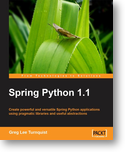3.2.3.4. Other configuration formats¶
3.2.3.4.1. PyContainerConfig - Spring Python’s original XML format¶
PyContainerConfig is a class that scans object definitions stored in the format defined by PyContainer, which was the original XML format used by Spring Python to define objects.
Warning
PyContainer’s format is deprecated
PyContainer’s format and the original parser was useful for getting this project started. However, it has shown its age by not being easy to revise nor extend. So this format is being retired. This parser is solely provided to help sustain existing Spring Python apps until they can migrate to the PythonConfig, XMLConfig or the YamlConfig format.
An important thing to note is that PyContainer used the term component, while Spring Python uses object. In order to support this legacy format, component will show up in PyContainerConfig-based configurations:
<?xml version="1.0" encoding="UTF-8"?>
<components xmlns="http://www.springframework.org/springpython/schema/pycontainer-components"
xmlns:xsi="http://www.w3.org/2001/XMLSchema-instance"
xsi:schemaLocation="http://www.springframework.org/springpython/schema/pycontainer-components
http://springpython.webfactional.com/schema/context/spring-python-pycontainer-context-1.0.xsd">
<component id="MovieLister" class="springpythontest.support.testSupportClasses.MovieLister" scope="prototype">
<property name="finder" local="MovieFinder"/>
<property name="description" local="SingletonString"/>
</component>
<component id="MovieFinder" class="springpythontest.support.testSupportClasses.ColonMovieFinder" scope="singleton">
<property name="filename">"support/movies1.txt"</property>
</component>
<component id="SingletonString" class="springpythontest.support.testSupportClasses.StringHolder">
<property name="str">"There should only be one copy of this string"</property>
</component>
</components>
The definitions stored in this file are fed in to a PyContainerConfig which scans it, and then sends the meta-data to the ApplicationContext. Then, when the application code requests an object named “MovieLister” from the container, the container utilizes an object factory to create an object and return it:
from springpython.context import ApplicationContext
from springpython.config import PyContainerConfig
container = ApplicationContext(PyContainerConfig("app-context.xml"))
service = container.get_object("MovieLister")
3.2.3.4.2. SpringJavaConfig¶
The SpringJavaConfig is a class that scans object definitions stored in the format defined by the Spring Framework’s original java version. This makes it even easier to migrate parts of an existing Spring Java application onto the Python platform.
Note
This is about configuring Python objects NOT Java objects
It is important to point out that this has nothing to do with configuring Java-backed beans from Spring Python, or somehow injecting Java-backed beans magically into a Python object. This is PURELY for configuring Python-backed objects using a format that was originally designed for pure Java beans.
When ideas like “converting Java to Python” are mentioned, it is meant that re-writing certain parts of your app in Python would require a similar IoC configuration, however, for the Java and Python parts to integrate, you must utilize interoperable solutions like web service or other remoting technologies.
<?xml version="1.0" encoding="UTF-8"?>
<beans xmlns="http://www.springframework.org/schema/beans"
xmlns:xsi="http://www.w3.org/2001/XMLSchema-instance"
xsi:schemaLocation="http://www.springframework.org/schema/beans
http://www.springframework.org/schema/beans/spring-beans-2.5.xsd">
<bean id="MovieLister" class="springpythontest.support.testSupportClasses.MovieLister" scope="prototype">
<property name="finder" ref="MovieFinder"/>
<property name="description"><ref bean="SingletonString"/></property>
</bean>
<bean id="MovieFinder" class="springpythontest.support.testSupportClasses.ColonMovieFinder" scope="singleton">
<property name="filename"><value>support/movies1.txt</value></property>
</bean>
<bean id="SingletonString" class="springpythontest.support.testSupportClasses.StringHolder">
<property name="str" value="There should only be one copy of this string"></property>
</bean>
</beans>
The definitions stored in this file are fed in to a SpringJavaConfig which scans it, and then sends the meta-data to the ApplicationContext. Then, when the application code requests an object named “MovieLister” from the container, the container utilizes an object factory to create an object and return it:
from springpython.context import ApplicationContext
from springpython.config import SpringJavaConfig
container = ApplicationContext(SpringJavaConfig("app-context.xml"))
service = container.get_object("MovieLister")
Again, the only difference in your code is using SpringJavaConfig instead of PyContainerConfig on one line. Everything is the same, since it is all inside the ApplicationContext.
Note
What parts of Spring Java configuration are supported?
It is important to note that only spring-beans-2.5 has been tested at this point in time. It is possible that older versions of the XSD spec may also work.
Spring Java’s other names spaces, like tx and aop, probably DON’T work. They haven’t been tested, and there is no special code that will utilize their feature set.
How much of Spring Java will be supported? That is an open question, best discussed on Spring Python’s community forum. Basically, this is meant to ease current Java developers into Spring Python and/or provide a means to split up objects to support porting parts of your application into Python. There isn’t any current intention of providing full blown support.
